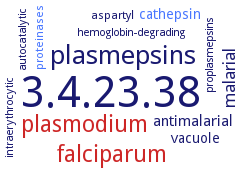3.4.23.38: plasmepsin I
This is an abbreviated version!
For detailed information about plasmepsin I, go to the full flat file.

Word Map on EC 3.4.23.38 
-
3.4.23.38
-
plasmepsins
-
falciparum
-
plasmodium
-
malarial
-
antimalarial
-
cathepsin
-
vacuole
-
aspartyl
-
proteinases
-
hemoglobin-degrading
-
intraerythrocytic
-
autocatalytic
-
proplasmepsins
- 3.4.23.38
-
plasmepsins
- falciparum
- plasmodium
-
malarial
-
antimalarial
- cathepsin
- vacuole
-
aspartyl
- proteinases
-
hemoglobin-degrading
-
intraerythrocytic
-
autocatalytic
-
proplasmepsins
Reaction
hydrolysis of the -Phe33-/-Leu- bond in the alpha-chain of hemoglobin, leading to denaturation of the molecule =
Synonyms
AH I, aspartic hemoglobinase I, malaria aspartic hemoglobinase, PFAPG, PfPM1, plasmepsin 1, plasmepsin I, plasmepsin-I, PLm I, PM I, PM-I, PMI
ECTree
Advanced search results
Cloned
Cloned on EC 3.4.23.38 - plasmepsin I
Please wait a moment until all data is loaded. This message will disappear when all data is loaded.
expression and partial characterization of soluble recombinant PM I from Plasmodium falciparum in which a truncated form of PM I (Lys77P-Leu329) (P indicates a propart residues) is fused to thioredoxin in the pET32b(1) vector, Trx-tPM I and expressed in Escherichia coli Rosetta-gami B (DE3)pLysS. The soluble fusion protein is purified from cell culture using a combination of Ni21 affinity and gel filtration chromatography and is capable of autocatalytic activation at pH 4.05.5, which occurrs at Leu116P-Ser117P, seven residues upstream of the native cleavage site (Gly123P-Asn1)
-
expression in Escherichia coli
expression of proplasmepsin I and V110P-proplasmepsin in Escherichia coli
-
expression of truncated proPfPM1 K110pN mutant in Escherichia coli
initial attempts to express full-length proplasmepsin I gene in Escherichia coli results in very low expression levels, possibly due to the toxic effects of the hydrophobic segment, and no activation to mature plasmepsin I is ever observed. Recombinant proplasmepsin I is expressed from pETPMI, a construct that is prepared from pET3a and contains the last 48 residues of the propart followed by the 328 residues of mature plasmepsin I. It is necessary to introduce a processing site, V110P, into the zymogen that renders the precursor capable of undergoing autoactivation
-


 results (
results ( results (
results ( top
top





